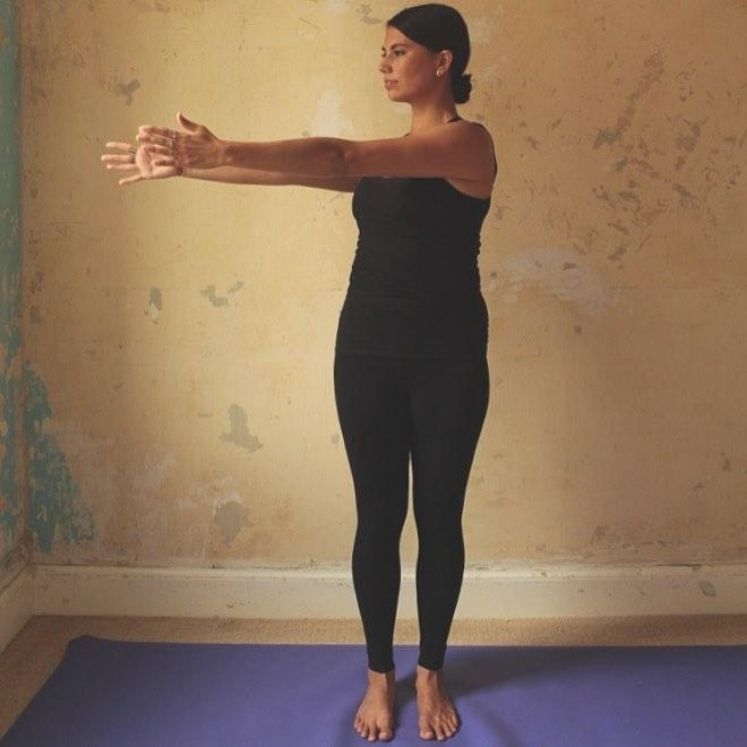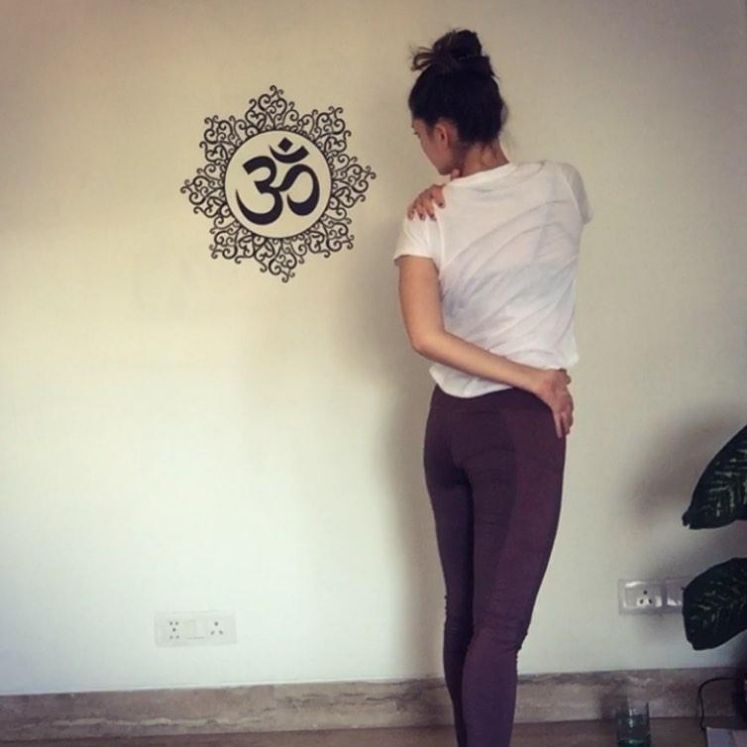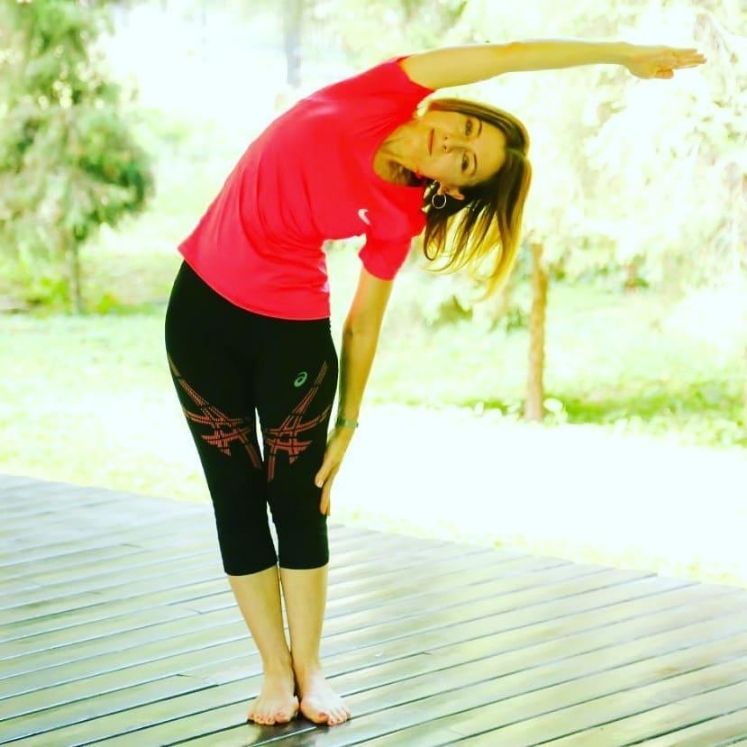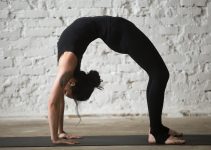
Katichakrasana is a standing spinal twisting pose where the trunk is allowed to rotate in clock and anti-clockwise. It cures stiff back, hips, and increase movability along with suppleness and flexibility.
It is a simple but powerful practice with multiple benefits. However, practitioners can perform it after a stressful asana to relax their body and before as a warm-up exercise.
This asana can be also scheduled as ‘classroom yoga’ and ‘office yoga’ due to its effective approach in dealing with stiffness, fatigue caused by overuse of trunk, neck, and shoulder muscles.
Meaning
Katichakrasana is a combination of three Sanskrit words where ‘Kati‘ means ‘waist’, ‘chakra‘ means ‘wheel or circular motion’ and ‘asana‘ means ‘pose.’
Therefore, This asana involves the rotation of waist primarily, along with the trunk in circular motion.
Practice Guide of Katichakrasana
This asana can be practiced safely by following the given steps.
Precautions & Contraindications
- While twisting, don’t rapidly jerk as it can overstretch knees.
- People with high blood pressure shouldn’t do katichakrasana at high speed.
- Don’t practice Katichakrasana during pregnancy, spinal injury, and sciatica.
Preparatory Pose
- Half Spinal Twist Pose (Ardha Kati Chakrasana)
- Half wheel Pose (Ardha Chakrasana)
Katichakrasana Steps
- Begin by standing straight, feet together, and spine erect i.e. in simple tadasana. Here, adjust your weight evenly on both feet.
- Now, spread up your legs at a shoulder-width distance and with inhalation, stretch your arms forward in front of the chest. It’s the centre position.
Here, palms should be facing each other and hands at the shoulder-width distance, parallel to the floor. - From the centre position, twist your trunk from the waist toward the right side with a gentle exhalation. Fix your gaze in direction to the right shoulder and keep twisting further with breathing out.
Here, maintain the gap between hands and keep your hips facing towards the front. - After a complete twist on the right side, inhale, free the twist lock, and come to the center position.
- Again, with an exhalation, repeat in the same manner to the left side and come back to the center with inhalation.
Hold katichakrasana pose for 20 seconds on each side and repeat each side at least 10 times.
Return back slowly by unlocking the twisted waist. Simultaneously shift your gaze from back to the front. Stand straight and breathe comfortably.
Variation
In some schools of yoga, Katichakrasana is taught in this way:

- Begin from standing or the initial position of Kati chakra asana. Feet should be at shoulder-width apart.
- This time place left hand on the right shoulder and right hand wrapping the lower back, bring it around the left side of the waist. Twist your body to the right, hold, and then come to the center.
- Come to the central position, exhale, and repeat in the same manner to the opposite side.
Anatomy of Katichakrasana
In Katichakrasana, we firmly glued our soles on the floor, and the torso is twisted to both sides while maintaining pelvic steadiness. It makes the whole rotational movement come to the spinal column. The spine gets a full twist of 120 degrees while the lowest vertebra twists about 10 degrees. This rotation from lower to upper back lubricates each vertebra of the spine.
However, the angle of rotation of the neck differs from the lower back, where the former possess 90 and the latter 30 to 40 degrees. But the spine has no role in restricting rotation but the rib cage does, due to rigidity of the thoracic area.
In the case of the movable or unsteady pelvis, knee and ankle joints are free to rotate. These along with synchronized arms movement facilitates rotation.
Beginners Tips
- Stiffness in back restricts twisting movement in beginners. To overcome this, grip your toes firmly on the mat and then try twisting like a free swing. The better the grip of feet the better will be twist.
- Try not to inhale while twisting, instead pull your navel back toward the spine with exhalation. The more relaxed will your abdominal muscles more easily it will be twisted.
Props and Modification
- Hold a rubber block in length between your palms in the centre position and press it gently. Now when you’re twisting, it will help you to maintain a gap in between your arms.
- In case of tightened shoulder, a modification of Katichakrasana can be performed. For this,
- Keep your arms down in the natural position. Twist your waist while hands swinging freely with twisting waist. Do not bend the arms. Take wherever they reach in these movements.
Then slowly come back to the center position.
- Keep your arms down in the natural position. Twist your waist while hands swinging freely with twisting waist. Do not bend the arms. Take wherever they reach in these movements.
Follow Up poses
- Mountain pose (Tadasana)
- Tree Pose (Vrikshasana)
Ardha Kati Chakrasana
Unlike katichakrasana, the waist twists only half of it so it’s called Ardha Kati Chakrasana – half spinal twist.

Begin by coming into Tadasana. Now, inhale and raise the right hand vertically upward, palm facing the left side, biceps touching the right ear. keep the left hand down by the left side.
Exhale and bend trunk to the left side. Left palm slides down along the thighs. Keep right elbow and both knees straight. Now, Breath slowly and maintain the pose here.
Inhale slowly while returning in hand raised or center position, hands down, and exhale in Samasthiti. Repeat in the same manner opposite side.
Katichakrasana Benefits
- To reduce occupational stress, practicing Katichakrasana along with other yogic practices reduces signs and symptoms of stress, A research study has proved it.
- In practitioners with stiffened back and abdominal muscles, regular practice of this asana loosens up the tissues to improve flexibility along with strengthening.
- Sometimes due to psychological stress and strong emotions, the autonomic nerve constricts and dilates the bronchi. Katichakrasana practice restores the depleted and blocked pranic energy, which positively affects bronchial asthma.
- Katichakrasana makes the rigid shoulders joints soft and supple with adding more movability in their movements, which helps in ‘Frozen shoulder‘. It also makes other bending and twisting asanas easier which requires flexible shoulder.
- Practicing Katichakrasana is helpful in managing weight and its concerning aspects. However, being overweight can make you more likely to develop high blood pressure. According to one of the research, this asana practice has its beneficial effect on weight and blood pressure.
- It shed off weight from the lower back and strengthens it. The swinging movements overcome the condition of constipation as well. Moreover, it also improves the blood circulation in the trunk and improves respiratory indexes.
- A person develops type-2 diabetes when his body becomes resistant to insulin or when the pancreas doesn’t produce enough insulin. The practice of this asana is proved to be effective in managing glycemic control in type 2 diabetes mellitus patients.
- The regular and appropriate practice of this asana stimulates the Manipura Chakra which is primarily responsible for the Digestive function. Hence, improves digestion.




